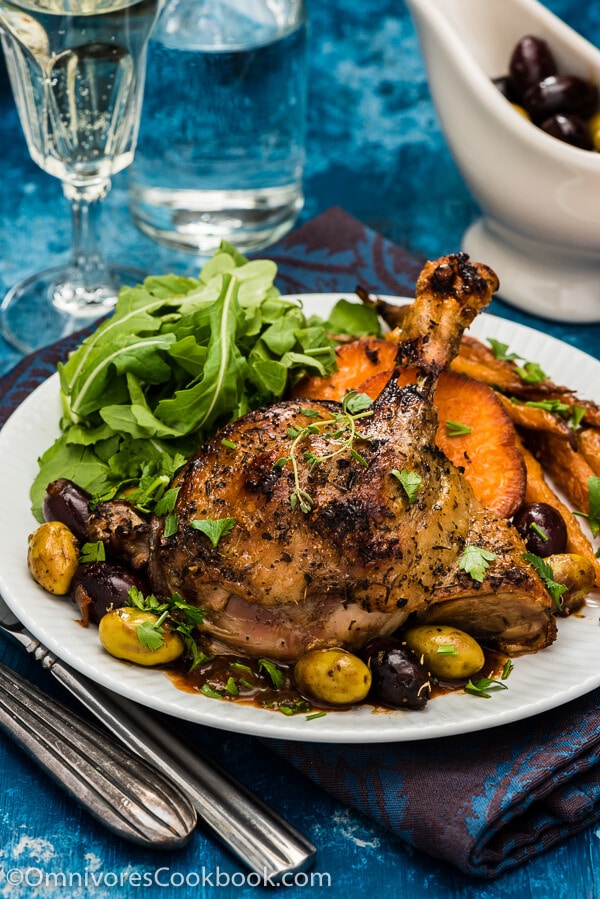
This slow roast duck features very tender meat, super crispy skin (just like confit), and a sumptuous olive sauce. It will take quite some time and effort to cook, but it’ll definitely be a highlight on your dinner party’s menu.
Thomas and I both love duck, and we have been doing search and studying, trying to roast whole duck at home to create a satisfying result. Just like roasting a perfect chicken, our goal is to create a moist and tender duck with crispy skin.
Cooking with a whole duck requires a whole different sets of techniques and seasonings. Neither of us had much experience on the topic, so we decided to do a series of experiments, learning from cookbooks before starting our own creation.

This is a recipe from The Slow Mediterranean Kitchen by Paula Wolfert. The original name is Slow-Cooked Duck with Olives. I made very few changes and followed the recipe loyally throughout cooking, and the dish turned out wonderful. This is a dish I recommend for the holiday season or a formal dinner party.
Thomas and I both love the texture and flavor of the finished duck. It is just like duck confit, with juicy meat and very crispy skin. Most of the fat will be rendered during cooking, so the skin will be paper-thin in the end. The olive sauce is gold, too. It adds great depth to the dish. We served the dish with roasted sweet potatoes and carrots, which are simply addictive with a bit of olive sauce drizzled on them.
The author describes this dish as a “quick” version of duck confit. However, to prep and cook this dish, you need at least a half day (the active cooking time will be about 1 hour).
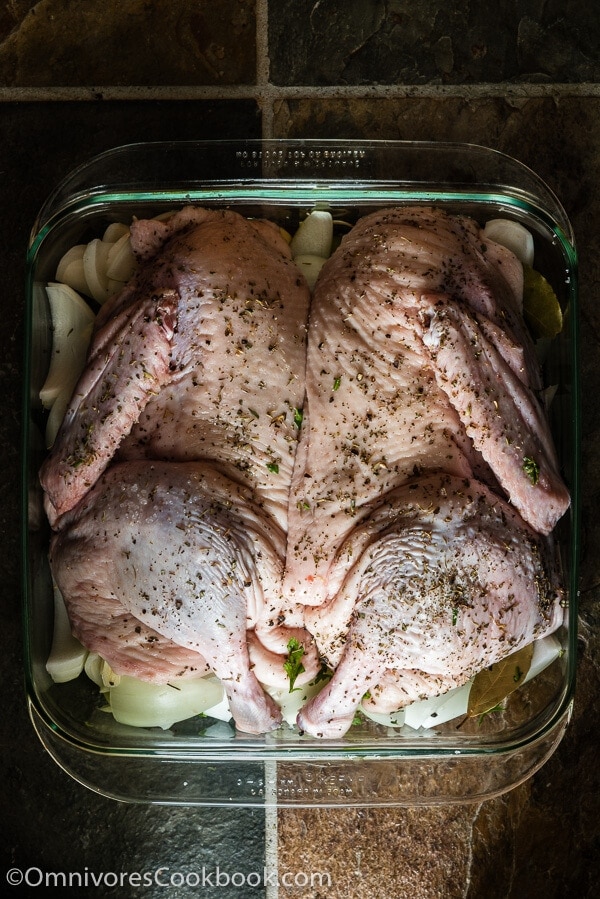
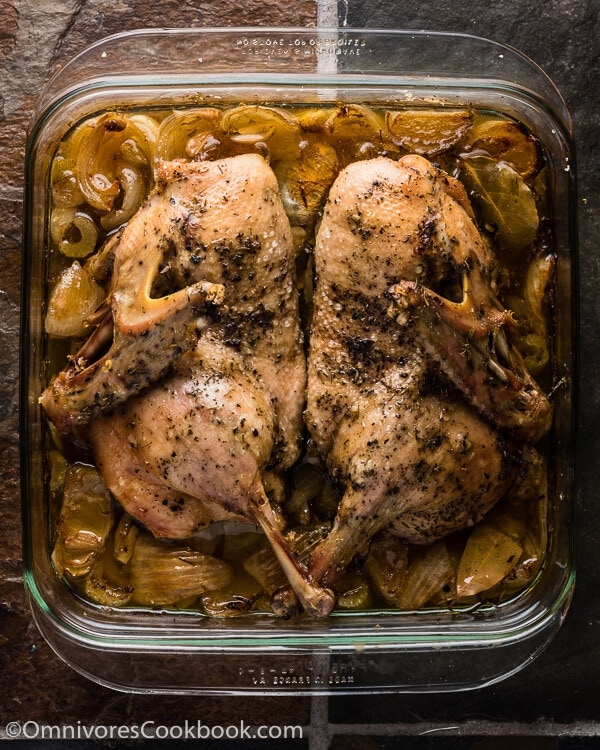
But the great part is that you can finish most of the process a day, or even a few days, before serving. On the day of serving, you can simply prepare some salad and roasted veggies. You need just 15 minutes or so to crisp the duck and reheat the sauce, and you’ll have a perfect main dish with sides.
The cooking process is long, but actually simple and straightforward, unlike stir-fry, which I cook almost every day and still occasionally screw up within a timeframe of one minute. The only tricky part might be halving the duck, if you’ve never done it before. You can refer to this YouTube video to learn how (it’s a video on how to halve a chicken, but the idea is the same). In fact, because the bones of a young duck are not very tough, you can easily achieve it with a chef’s knife – no cleaver needed.
I hope you enjoy the recipe!
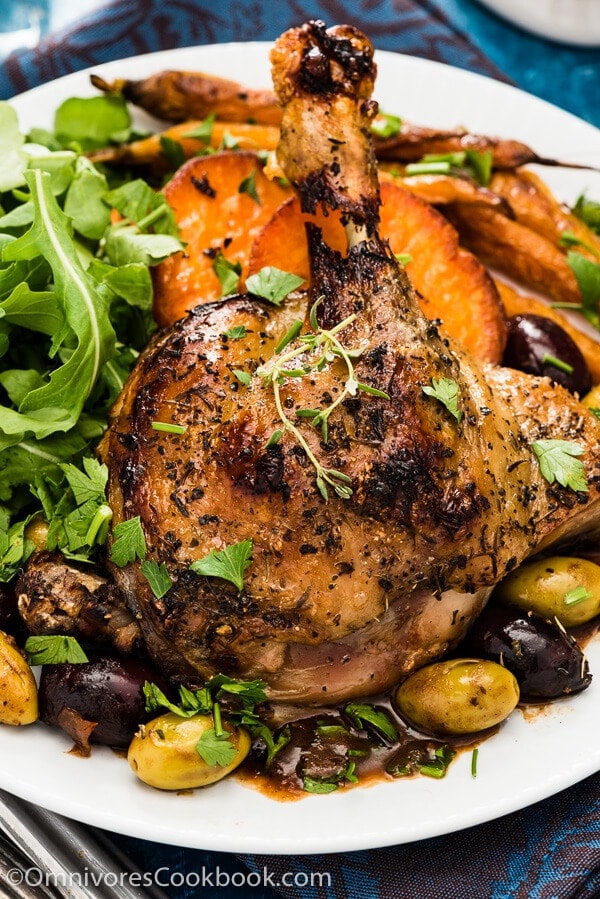
Do you like my recipes? Sign up for Omnivore’s Cookbook’s weekly newsletter to get the latest updates delivered to your inbox and a free e-cookbook! And stay connected via Facebook, Instagram, Pinterest and Google+. Thanks for reading and happy cooking!
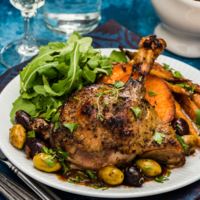
Mediterranean Slow Roast Duck with Olive Sauce
Ingredients
Duck
- 1 whole (5 pound / 2.3 kg) young duck
- 2 medium sized onions , coarsely chopped
- 1 large celery rib , sliced
- 8 garlic cloves , halved
- 1 and 1/2 tablespoons fresh thyme , chopped (or 2 teaspoons dried thyme)
- 1/4 cup parsley , coarsely chopped (plus extra to garnish)
- 2 bay leaves
- 2 teaspoons sea salt
- 1 teaspoon freshly ground black pepper
- 1 teaspoon herbes de Provence
Sauce
- Neck back, wing tips, heart, and liver of the duck (*see footnote 1)
- 1 medium sized onion , sliced
- 1 tablespoon tomato paste
- 1/2 cup dry white wine
- 1/2 teaspoon of sugar
- 1 cup homemade poultry stock (or boxed chicken stock)
- Salt and black pepper to taste
- 1 and 1/2 cups pitted olives
- 1/4 teaspoon herbes de Provence
Instructions
Duck
- Preheat oven to 475 degrees F (245 C). Prepare a 9 by 11-inch roasting pan.
- Spread onion, celery, cloves, thyme, and parsley in the pan to make a bed for the duck.
- Halve duck according to this YouTube video. Save the neck, back, wing tips, heart, and liver for the sauce.
- Combine sea salt, black pepper, and herbes de Provence in a small bowl.
- Prick the duck skin every 1/2 inch with the tines of a fork. Rub both sides of the duck with the sea salt mixture. Set duck on top of the veggies, skin side up.
- Roast uncovered for 10 minutes.
- Reduce the oven temperature to 275 degrees F (135 C).
- Cover the pan with aluminium foil. Return the pan (you don’t need to wait until the oven temperature drops to 275 F) to bake until the duck turns very tender, about 3 and 1/2 hours.
- Prepare the sauce while baking the duck.
- Turn off the oven. Let the duck sit in the oven for another 30 minutes.
- Carefully transfer the duck to a work surface. The duck will be very tender now and the meat will fall apart easily with a simple pull. Remove loose bones by hand. Discard the bones and the veggies in the pan. Save 1 teaspoon duck fat for later use. (Footnote 2)
- Quarter the duck - use a sharp chef’s knife to cut the duck into two equal pieces, between the breast and thigh. As most of the bones have been removed, it should be easy to slice the duck without affecting its shape.
- Wrap each piece of duck with aluminum foil to keep it moist until you’re ready to serve it. If you’re making the duck a day ahead, place the wrapped duck in an air-tight container and store in the fridge. If storing longer, place the container in the freezer.
Sauce
- Add the bones, heart, and liver of the duck into a nonstick skillet, skin side down. If you are not using a nonstick pan, grease the pan with some oil before adding the bones. Cover and cook over medium low heat until the all pieces are browned.
- Add onion. Continue cooking and stirring until the onion is browned, about 10 minutes.
- Add tomato paste. Cook and stir until slightly charred.
- Pour white wine into the skillet and quickly scrape off the brown bits with a spatula.
- Add sugar, stock, and 3 cups water. Cook over medium high heat until boiling. Turn to medium low heat and simmer for 1 hour.
- Strain the sauce and transfer to a fat separator. Discard the fat and return the stock to the skillet.
- Cook over medium high heat until the sauce reduces to 1 cup.
- Transfer the sauce to an air-tight container and store in fridge.
Serve
- About 10 minutes before serving, preheat broiler, line a baking tray with aluminum foil, and spray with oil. Start reheating the sauce.
- Generously season duck with salt and pepper. Place on the baking tray, skin side up. Dab the saved duck fat on top.
- Transfer the sauce to a sauce pan. Add olives and cook until the sauce is heated through. Adjust seasoning with salt, pepper, and herbes de Provence. (Footnote 3)
- Crisp and heat the duck 10 inches under the broiler. You should watch closely during this step, because the duck will heat up and char very quickly. Pull the duck from the oven as soon as the skin is crisped.
- Transfer the sauce with olives onto plates. Place the duck on top and garnish with parsley. Serve warm as main.
Notes
- Duck liver and heart add great flavor to the sauce. If you don’t feel comfortable using these parts, skip them and just use the bones.
- You can reserve the remaining duck fat for other cooking or discard it.
- When I was cooking this recipe, I found the sauce still a bit thin after reducing to 1 cup. I kept reducing the sauce until it thickened, but it left me very little sauce to serve. You can whisk 2 teaspoons potato starch with 2 tablespoons water. When the sauce is done, turn off heat and slowly whisk in the slurry. Do not add all at once. Add slowly and stir the sauce until it reaches the desired thickness.













Never thought of halving a duck! I always stuffed it with a bit of onion and roasted it on an elevated rack. Every 20 minutes or so I pricked the skin all over with a large 2-pronged fork. That way, the meat is less greasy and there’s lots of yummy duck fat in the roastiing pan below! (This was originally my goose method)
I like the make-ahead method. I wonder if it would pass TSA in one’s carry-on …..
P.S.–the liver makes a lovely pate’ (where’s that accent aigu), even if the animal has not overeaten.
That is a great idea! When we’re cooking the duck last time, I salt and pepper the liver and ate it. Quite nice but not as good as a pate. Will keep this in mind and try it out next time.
I didn’t know much about roasting a whole duck. When I saw this recipe, I thought it’s quite interesting and different, so decided to try it out. I think the stuffing method should work out very well too. I need to get a an elevated rack and try it out. What kind of seasoning do you use?
Probably will pass TSA since it’s already cooked??
Roasting a whole duck is how I usually do it, but slow cooking it as you describe. If you prick it, salt it, and loosely stuff it with citrus, that cuts the fat as well.
I want to try the olive sauce- sounds like a nice variation. I usually make a fruit sauce. I dissolve some corn starch into a favorite wine, then stir in some preserves, and heat everything through until the corn starch starts to thicken the mix, then puddle the sauce on the plate, place the duck on it, then spill a bit more over the duck, and have more sauce to pass around. Any fruit preserve works well, as long as you balance the flavors with your wine. My favorites ate raspberry and blueberry, but sometimes it depends on what I have in the cupboard, when I’m in the mood for duck 😉 Add a side of wild rice or a good basmati, and serve with a spinach salad, and you’ve a meal fit for royalty 😉
I figure the duck livers are “Cook’s Privilege”, and the other bits get saved for stock. And, NEVER throw out duck fat. Use it to fry your eggs in the morning, or dress your toast- or if you make a bacon dressing, sub the duck fat for the bacon fat in a warm vinaigrette style salad dressing.
Not very politically correct to eat fat nowadays, but if you don’t overdo it, works in well with a balanced diet 😉
Do you use a V-rack to roast the duck in the oven? I think one of the reasons to halve the duck is to keep all the surface crispy. But I admit I always find the roasted whole duck is a bit more moist. I’m planning to cook another duck very soon, and I’d love to try out your method. We do not have a rotisserie oven, so I think the next best thing will be a roasting rack. One question, when you stuff the duck with citrus, do you remove the rind? I imagine the rind will infuse a bitterness to the duck?
The olive sauce turned out very nice. It’s heavier than the fruit type, but worked very well in this dish. It also goes well with roasted winter veggies. The fruit sauce sounds lovely. I think a fruity sauce always goes very well with goose and duck (and foie of course!). In Chinese cooking we usually serve the duck with plum sauce. I’d love to make a fruit sauce next time, to serve with the duck. I like blueberry, and maybe also try apple.
As for the liver part, I need to think of a better way to cook it. Last time I boiled it with the sauce and it’s a bit overcooked. I seasoned and ate it directly. Next time I’ll try to make a pate out of it. We kept the duck fat last time. It works very well in stir fry rice, with very basic ingredients. I don’t usually recommend using fat in cooking on my blog, but I certainly like it 🙂 Oh right, sometimes we rub some duck fat when roasting a chicken. Might sound weird, but the dish will turn out very delicious 🙂
I’ve used a V-rack once or twice, when I had one in someone else’s kitchen, but I’ve also rested a grill over a drippings pan, or improvised a “rack” out of crumpled tin foil to keep the duck elevated out of the fat and juices. I do a lot of camping, so I’m used to improvising whatever I need from whatever I have in my mess box.
The trick is to keep as much of the skin exposed to the dryness and heat as possible for that lovely crispy texture. While I’ve done Peking Duck the official way, you can still get that lovely skin without all the hassle of blowing up the duck and hanging it in front of a fan, if you pierce, salt, and slow cook it as exposed to the heat as possible. Never tried a rotisserie- don’t have one- but I bet it would work. Having said that, I think I might try the spinning string trick next time I have a camp fire to play with (You truss the bird, usually a chicken, hang it from a long string, next to the fire over a dripping pan, and twist it so it spins, so it heats evenly. Hafta be careful or you’ burn the string through, and have a bit of a mess to cuss out .) If nothing else it will entertain the neighbors 😉
Found a video: https://www.youtube.com/watch?v=hkUxfexdqK4
As far as the citrus, no, no rind or pith, just the membrane that holds the sections together. You can break up or pierce a few of them, but not too many or the juice will render out before the duck finishes cooking.
I think a plum sauce, particularly using that lovely plum wine the Chinese make so well would be lovely, but I think apple might be a bit too bland, unless you use a fairly strong favored apple cider. Apple juice, at least here in the US isn’t much more than sugar water, and duck, being a richly favored meat, needs richly favored accents.
Do, however, use the corn starch for a thickener, because of the lovely translucency it gives the sauce. (Does rice starch thicken the same way? Never tried it- might have to.)
As far as the liver goes, I just dust it with seasoned flour and gently saute it until done, which isn’t very long. Too many people cook liver until it’s just nasty, and properly done, it’s tender and tasty- and good for you 😉
Gosh you read my mind. I was just thinking about cooking Peking duck and has been doing some research on the topic. Do you still have the recipe you’ve tried before? My recipe includes the steps of pouring boiling water over the duck, paint with a syrup mixture, air-dry overnight, stuff the duck (with apple and bread), and roast at 350 F until cooked through.
The slow cooked duck will generate paper thin crispy skin. But a properly cooked Peking duck skin is quite fatty, fluffy and crispy. I think the major difference is, you don’t want to let the fat to be totally rendered when you cook a Peking duck (it might be a bit greasy for some people, but I really like its texture). On the other hand, the real way to cook the duck is to hang it in a brick oven and cook it at 500 F for about half an hour. It’s so difficult to achieve at home. So maybe the slow cooking method is the best one after all. Anyhow, I’ll need to try out both in the kitchen before I can make a conclusion.
To speaking of roasting rack, I just read http://www.seriouseats.com/2010/09/the-food-lab-how-to-make-peking-duck-at-home.html. They jam the duck on a beer can and roast it vertically. Very interesting idea and worth to try out!
Thanks for sharing the video. The spinning methods look like fun! Actually it is really similar to the traditional way to cook Peking duck (they use a metal hook instead). The string does look a bit dangerous. Maybe you can try metal chain + hook? At least it won’t catch fire…
The only reason I mentioned apple sauce is, I once had a very delicious foie gras dish (it used fresh duck liver) that was served with an apple sauce. Its texture is a bit like apple butter, and it goes great with the foie. But I agree, the duck meat is very rich and I probably need a rich sauce to go with it.
I never tried rice starch. Potato starch and tapioca starch work as well as corn starch though.
Now I have two duck recipes to test! Let’s see how the cooking goes 🙂
I saw this while we were traveling, Maggie, and knew I had to see more when we got home. This dish is spectacular and I love that you can prepare it ahead of time and just crisp it up the day you serve it. No one wants to be tired from a long day of cooking when you’re entertaining.
I love that you always break down a dish into easy steps so that it doesn’t feel like a big job.
I have never cooked a duck but it looks perfect for the holidays and we love the taste so I think it’s time!
The youtube video is no longer available 🙁
I’m hosting Easter and have a few people with pork allergies so want a chicken option for them. Last night I did a trial run with this recipe using chicken… it worked great!!! I lowered the oven to 170F (instead of 275F) and cooked it for 7 hours, basting every hour. Followed the rest of the recipe to a T. Pretty sure it was the best chicken I ever made.